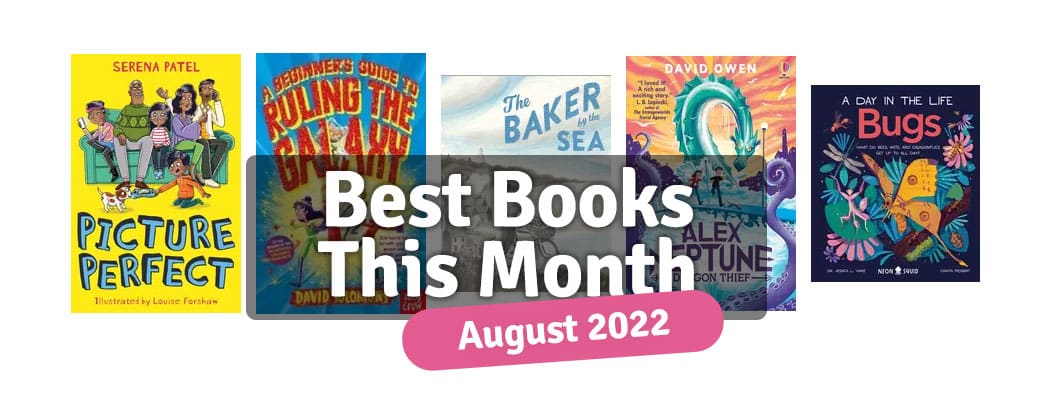It’s easy to feel lost in the flood of so many new children’s books available. Each month, we pick five of our recently published favourites.
Check out our Review Panel’s top picks for you to read in August 2022.


It’s easy to feel lost in the flood of so many new children’s books available. Each month, we pick five of our recently published favourites.
Check out our Review Panel’s top picks for you to read in August 2022.
Sonal has chosen ‘family’ as the topic for her school photography project. She thought it would be easy but she’s already regretting it. She can’t get everyone to focus so that she can take a group photo and even the individual snaps feature different members of her family looking at screens of various kinds. Sitting with her grandfather and sadly comparing her photos and family albums from the past shows just how much the digital world has taken over their lives. Egged on by her wise and long-suffering grandpa (who we suspect has thought for a while that a digital detox was in order), Sonal devises a plan for a family camping weekend without any devices at all.
From there, the warmly engaging story follows the innocently well-meaning but accident-prone heroine, whose exploits provide amusement while inviting empathy. Serena Patel captures the rhythms and cadences of modern family life brilliantly, wryly presenting an antidote to the perfect families often seen on social media. I thoroughly enjoyed the realistic perspective on parental and sibling relationships where squabbles and disagreements are normal.
Like the rest of the Barrington Stoke series, it is accessible but well-written and unpatronising, with black and white illustrations that work well with the lighthearted tone of the writing. It would make a great start to discussions of the mismatch between reality and social media profiles within the context of families. The more we expose this in schools the better, and this book does so in a gently unthreatening way.
Recommended as a read for pleasure for children in Year 4 and upwards who are developing reading stamina.
David Solomons’ science fiction adventures are laugh-out-loud funny and have won several book awards. In this latest, Gavin finds himself with the fate of the world in his hands. The new girl at school, Niki, is really getting on his nerves, following him everywhere and declaring that she has never seen anyone so cosmically insignificant. He doesn’t believe her assertion that she is a galactic princess, trying to evade her warring, alien despot parents.
However, a series of surreal events including being taken hostage by a talking bounty hunter cat called Cupcake, soon make him change his mind. To avoid Earth being obliterated, Gavin must help Niki’s crew repair her spaceship as well as try and bring her parents together again.
Family and friendship are at the heart of this story. Gavin is fostered but worried that he is about to be moved on again, ousted by the baby he calls the Tiny Horror. Although Niki may seem to live a privileged life as a princess, her parents are fighting, forcing her to choose between them. Despite her annoying behaviour, Gavin realises he will miss Niki if she leaves whilst she has come to understand that families can grow from other relationships.
Hilarious and ultimately heartwarming, with inventive detail, this will appeal to readers in upper KS2.
This sublime picture book is written and illustrated by Paula White, set in the beach village that once stood where she grew up in Lowestoft, a port with a rich fishing heritage, on the East Coast of Suffolk. The village housed the working community along with the Scottish fisher girls and men, who followed the fish along the east coast, arriving to help pack and preserve the catch.
Accompanying a lyrical text, the atmospheric illustrations in pen and ink, using a muted palette of blue and grey, with yellow highlights, depicts a traditional way of life. The young boy at the heart of the story takes the reader on a walk around the wooden buildings and small shops, introducing the grown-ups of the village going about their work, including the fishermen, the blacksmith and the boat-builders. The boy’s father is the baker, but the boy wants to be a fisherman when he grows up, braving the stormy seas, catching the fish to feed the community and provide an income for the village. While helping out in the bakery, the boy’s father explains that without his bread, buns and biscuits, many of the others wouldn’t be able to do their jobs.
The bread is used by the café to make bacon butties for the boat builders, the fresh, hot buns warm the fingers of Scottish girls as they pack the barrels while the fisherman out at sea dunk their savoury biscuits in hot broth to stave off cold and hunger. The baker is proud of his place in the community and the boy realises that everyone has their part to play.
Suffused with warmth and nostalgia, this evocation of bygone times should help to inspire discussion and exploration of community, local and family history. Paula White dedicates the book to her grandfather, who, she explains, was a baker but sometimes felt guilty for not being a fisherman. It also includes his recipe for hot coconut buns.
Alex Neptune lives in the seaside town of Haven Bay, which is rather unfortunate as he thinks the sea is trying to kill him. He is not allowed to go anywhere near the sea; his grandad has forbidden it. However, this only makes Alex’s fear of water worse. Zoey Wu is Alex’s best friend and an inventor. She does have a tendency to blow things up or set them on fire though…
One day, their new friend Anil Chatterjee finds an octopus that takes a liking to Alex and seems to be trying to communicate with him. A whole host of other seaside creatures start acting rather strangely as well: Pinch the seagull, a group of sea otters and an army of crabs. The water in Haven Bay has recently turned foul and the locals are determined to find out why. Does it have something to do with a strange new building called the Station? And why do the animals seem to want Alex to visit the abandoned aquarium?
It’s not long until the annual ‘Water Dragon ceremony’ which celebrates the local legend of a mythical creature called the Water Dragon that supposedly created the bay. Alex, Zoey and Anil find themselves investigating the mysterious goings-on and uncovering more than they bargained for.
I really enjoyed the eco-themes mixed with magic in this book – a great combination! The humour and development of friendship between the characters were enjoyable elements as well. The friendship dynamics are something that children most likely will relate to, with Alex and Zoey being best friends and Anil being a new friend that comes along. ‘Alex Neptune’ will be enjoyed by fans of ‘Malamander’ and other legend-based adventures. It would also make a good class read for children in Year 5 or 6 and could link to a topic that covers pollution or be a good starting point for writing their own legends.
Bugs (A Day in the Life) is set over a 24-hour period, during which you get to meet the coolest insects on earth and follow the lives of individual bugs as they fly, hunt, hide, and scuttle their way through their day.
Bug expert Dr Jessica L. Ware introduces characters from cicadas to butterflies in the style of a nature documentary, with a sprinkling of simple science explanations which is perfect for future zoologists. This book is jam-packed with facts and fun science; my class could not wait to find out the next incredible insect on the daily journey.
The book invites readers to become witnesses of incredible moments of nature, including a dragonfly escaping a hungry frog and a gigantic comet moth with superpowered wings. It really shows us what an incredible place Earth is and how the smallest of insects behave.
The book is beautifully illustrated by Chaaya Prabhat through vibrant and bright colours. The clear Contents, Glossary and Index pages really support children’s learning of how to navigate through nonfiction texts – a very important skill to develop. Children of all ages who love insects will be able to access this book at differnet levels, from the very young being able to study the illustrations through to older children exploring the facts and linking them to the wider ecosystem.
A perfect book to allow the reader to spend the day with the most fascinating insects on the planet.
Reviewer: Helen Wilson


© BooksForTopics 2015-2024
review
Year group(s) the book is most suitable for:
Year group(s) the book is most suitable for:
Does the book contain anything that teachers would wish to know about before recommending in class (strong language, sensitive topics etc.)?
Does the book contain anything that teachers would wish to know about before recommending in class (strong language, sensitive topics etc.)?
Would you recommend the book for use in primary schools?
yes
Curriculum links (if relevant)
Curriculum links (if relevant)
Any other comments
Any other comments